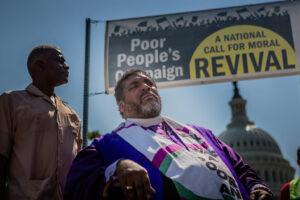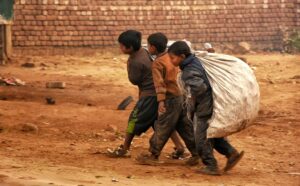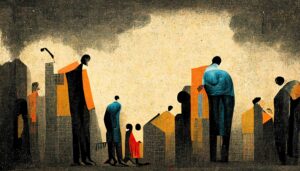Living on a Dollar a Day
Nearly 1.8 billion people live in extreme poverty, most barely surviving on $1 a day. A new book of photography documents the everyday lives of the world's poorest people. E-WASTE DUMP, ACCRA, GHANA: In an e-waste dump that kills nearly everything that it touches, Fati, 8, works with other children searching through hazardous waste in hopes of finding whatever she can to exchange for pennies in order to survive. While balancing a bucket on her head with the little metal she has found, tears stream down her face as the result of the pain that comes with the malaria she contracted some years ago. This is work she must do to survive. Photo by Renée C. Byer
E-WASTE DUMP, ACCRA, GHANA: In an e-waste dump that kills nearly everything that it touches, Fati, 8, works with other children searching through hazardous waste in hopes of finding whatever she can to exchange for pennies in order to survive. While balancing a bucket on her head with the little metal she has found, tears stream down her face as the result of the pain that comes with the malaria she contracted some years ago. This is work she must do to survive. Photo by Renée C. Byer
“Living on a Dollar a Day: The Lives and Faces of the World’s Poor” A book by Thomas A. Nazario and Renée C. Byer
Nearly 1.8 billion people on our planet live in extreme poverty. Most are barely existing on $1 a day. Often that dollar is stretched to support a family of six. In comparison, the world’s 1,426 billionaires make, on average, $273,973 a day. That daily figure is more than 20 percent higher than what the world’s poorest citizens will ever make in their lifetimes.
This great disparity was the driving force behind the book “Living on a Dollar a Day: The Lives and Faces of the World’s Poor” by child advocate and lawyer Thomas A. Nazario and Pulitzer Prize-winning photographer Renée C. Byer. Nazario is founder of the San Francisco-based nonprofit The Forgotten International, whose mission is bringing awareness to the plight of the poor and providing grants to grass-roots organizations on the front lines. Two hundred glossy, large format photos by Byer, who also provides some text, document the everyday lives and struggles of the world’s poorest people.
The recipient of the 2014 International Photography Award for best documentary book, the four-year project covered 10 countries on four continents, capturing extreme poverty in small villages and large slums. “Living on a Dollar a Day: The Documentary” is in the works.
Although hard data and statistics are vital, they are not usually the best way to elicit a response. Our ability to relate to such unimaginable conditions is muted by the comfort of our homes and the view through our big flat screen TVs, tuned to the recent shenanigans of spoiled rich kids and entitled celebrities.
What Byer and Nazario have painstakingly accomplished is a visual and emotional connection that will hopefully incite readers to action.
Byer’s intimate photos draw us into examining every minute, disconcerting detail. The attention and care given to each family is evident. We want to know who these people are and what will happen to them.
With an introduction by the Dalai Lama, the 10 chapters focus on issues such as “Children at Work” and “Health Care.” The stories enlighten detractors who think poor people are just lazy, a recurring argument spewed by the privileged.
The chapter “Women at Work” provides countless examples to counter that argument. Jacaba Coaquira, an 80-year-old Bolivian farmer, works from 7:30 a.m. to dusk, gathering oats and green beans. Unable to feed her cow and donkey, she walked five hours to the closest town to sell them. Then there’s 25-year-old disabled single mother Jestina Koko and her 5-year-old daughter Satta in Liberia. Crippled since childhood, Koko scoots around by dragging herself on her arms. She survives by doing laundry, selling cookies and begging. Her only wish is to make enough money to send her daughter to school. Their temporary home is a sliver of dirty floor where they squat in a doorway.
In Ghana, families of 20 often share makeshift shanties, one-room huts with no bathroom or running water. It’s reprehensible to see anyone living in such squalor when criminals in U.S. prisons are allotted more rights, a decent bed and three square meals a day. The only mistake these people made was being born into unfortunate circumstances and countries plagued by war, famine, natural disasters and tyranny.
Romanians continue to suffer from the rule of former dictator Nicolae Ceau?escu. His mass procreation mandate forced women to give birth to hordes of children without any means of support. Generations of abandoned youths now live in underground sewers.
Scattered throughout the book are informative charts and lists on important issues facing the underprivileged: child labor, human trafficking, 10 worst countries to be born in (Sierra Leone is No. 1) and largest slums (No. 1 is Mexico City’s with an estimated 4 million people).
One third of the world’s poor live in India. Ironically, India is also home to the world’s first billion dollar residence, built by tycoon Mukesh Ambani — net worth, $23.6 billion. Three miles from Ambani’s Mumbai mansion-in-the-sky are the Dharavi slums and the “beggar mafia,” a syndicate known for intentionally blinding and amputating the limbs of children to garner more sympathy from tourists.
India is also home to the world’s most disgusting job — maila dhona (lifting feces). For a mere 91 cents a day, women sweep excrement-filled floors with a broom and tin plates, which, when full, are piled in baskets on their heads to carry to disposal areas. Men descend into latrine pits or septic tanks immersed in human waste with a bucket and no protective gear. It is hell on earth, but according to Dante’s “Inferno,” there’s a special place in the fourth circle of hell reserved for the sins of unrestrained greed and material wealth.
Being confronted by photos of deplorable living conditions and needless suffering was overwhelming at times. I confess that I had to put the book down several times and watch a cute puppy video. By far the most heartbreaking photos and stories are those of children who, combined with women, make up 60 percent of the poor.
Byer, who considered this book a dream assignment despite the emotional devastation, captured innumerable photos of children playing in garbage dumps heaped with rotting trash, and scavenging through piles of hazardous e-waste with their bare hands, searching for a piece of metal to trade for pennies. In her text, Byer details what we can’t experience as readers — the intense, sweltering heat and unbearable smells.Eighteen thousand children under the age of 5 die every day from causes that are preventable. Access to health care is nearly nonexistent. Many suffer from AIDS, malaria, tuberculosis, drug addiction and now Ebola. Families resort to desperate measures. Weighing just 9 pounds, 2-year-old Sangeeta was being starved by her mother in India’s Charan slum to better care for her five other children.
But there are moments of happiness to be found. In Cambodia sits a cluster of ramshackle stilt huts, surrounded by a toxic green swamp. A naked little boy runs across dilapidated boards, laid over the polluted water, filled with overflowing bags of garbage and unidentifiable debris. There is a huge smile on his face. The same look of glee you’d see on any playground.
“We didn’t find a great correlation between lack of wealth and joy … particularly in children,” Nazario said in a July radio interview on the “Leonard Lopate Show” on WNYC.
The chapters “And Yet the Children Play” and “Hope” reveal that despite the lack of toys and comfort, simple things like a vine transformed into a jump rope can still bring laughter amid such sadness.
For every Warren Buffett, who pledged the bulk of his $2.1 billion fortune to the Bill and Melinda Gates Foundation, there’s a callous government official who simply doesn’t care.
Nazario recalls a meeting with members of India’s parliament about their poor. They nonchalantly said, “We have over 200 million people living on our streets and if they died tomorrow we wouldn’t miss them at all.”
Kleptocracies and dictatorships run rampant in Third World countries. Often, money received never trickles down, or is used to pay off loans to other countries. This widespread corruption causes potential donors to hesitate.
The Forgotten International, Nazario’s nonprofit group, focuses on funding and working with small organizations, the little clinics and schools that work on the very basic levels, precisely because of that innate distrust of big government and large bureaucratic agencies.
A book featuring some of the most deplorable living conditions on earth may be easy to push aside as too much doom and gloom, but don’t.
Byer’s moving photographs and captivating, honest storytelling will reach out and touch your soul. They are meant to rattle nerves. And yes, perhaps motivate us to do something, anything.
Conveniently provided at the end of each chapter are “Way to Help” sections, listing dozens of grass-roots organizations that have been vetted by The Forgotten International, such as the Mae Tao Clinic in Thailand and the Tong-Len Charitable Trust, which provides clean water, a mobile clinic and a tent school that teaches reading, writing and social skills. I was relieved to learn that 2-year-old Sangeeta was saved thanks to their intervention.
“Caring and compassion is one thing,” Nazario said. “Being willing to relieve suffering of someone else, that’s what is critical.”
Your support matters…Independent journalism is under threat and overshadowed by heavily funded mainstream media.
You can help level the playing field. Become a member.
Your tax-deductible contribution keeps us digging beneath the headlines to give you thought-provoking, investigative reporting and analysis that unearths what's really happening- without compromise.
Give today to support our courageous, independent journalists.






You need to be a supporter to comment.
There are currently no responses to this article.
Be the first to respond.